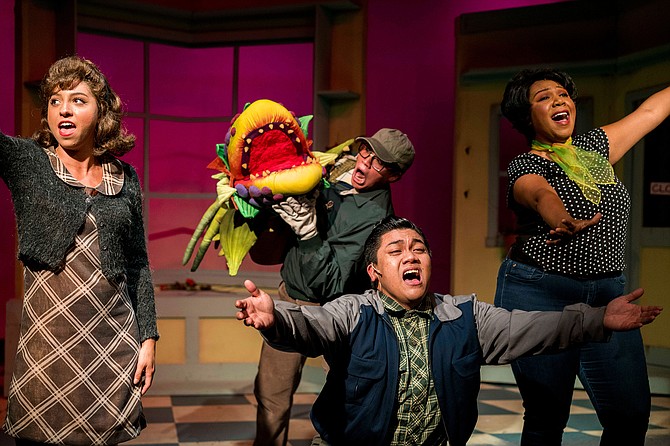 Facebook
Facebook
 X
X
 Instagram
Instagram
 TikTok
TikTok
 Youtube
Youtube

Like the undercard of a title fight, a B Movie in the 1930s was the show nobody had come to see, but watched anyway because it was included with the price of the ticket. Thus, studios would make an A movie to attract customers, with bona fide movie stars and high production values, then package it with a cheaply made genre picture, starring nobody, and call the whole thing a double feature.
By the 1950s, A Movies were popular enough to sell tickets on their own, and yet America’s fondness for B Movies persisted, in part due to the subject matter. Special effects weren’t yet convincing enough for large budget films to convincingly tackle fantasy and science fiction, so fans of such strange and speculative tales sought out B movies at drive ins, or paired together as low budget double features.
Arguably the B-est of the B movies is Roger Corman’s 1960 production of Little Shop of Horrors. It tells the simple story of a carnivorous plant from another planet that exploits the low self esteem of a nerdy skid row orphan to feed its bloody appetites. But what made the movie truly impressive was the haste in which it was made. Lore has it that principal photography for the feature length film took just two and a half days, making it one of the fastest movies ever shot. And it earned money just as fast. According to IMDb, though it cost less than $30 thousand to produce, it grossed $1.4 million the year it was released, mostly riding double feature bills with other low budget flicks.
One of the 20th century’s most prolific filmmakers outside of porn, Corman produced hundreds of movies, and once directed nine in a single year. He delivered unto American cinema the forgettable titles Attack of the Crab Monsters and The Saga of the Viking Women and Their Voyage to the Waters of the Great Sea Serpent. We can laugh about them now, but they say the King of the Bs turned a profit on just about every movie he made. He succeeded not always with artistic merit, but with the classic American combo of high return on low investment.
In the early 80s, Little Shop of Horrors was adapted as an off-Broadway musical, where it couldn’t lean on volume to thrive. Instead, it relied on the talents of frequent collaborators Howard Ashman and Alan Menken, who went on to greater fame writing Disney musicals including Little Mermaid and Beauty and the Beast. A funny thing happens to a B movie plot when you dress it up with great doo-wap inspired songs by masters of their craft, then put together a cast with beautiful voices to perform them. It reveals how well it might have turned out given the A movie treatment.
Little Shop of Horrors plays at New Village Arts until August 4.


Like the undercard of a title fight, a B Movie in the 1930s was the show nobody had come to see, but watched anyway because it was included with the price of the ticket. Thus, studios would make an A movie to attract customers, with bona fide movie stars and high production values, then package it with a cheaply made genre picture, starring nobody, and call the whole thing a double feature.
By the 1950s, A Movies were popular enough to sell tickets on their own, and yet America’s fondness for B Movies persisted, in part due to the subject matter. Special effects weren’t yet convincing enough for large budget films to convincingly tackle fantasy and science fiction, so fans of such strange and speculative tales sought out B movies at drive ins, or paired together as low budget double features.
Arguably the B-est of the B movies is Roger Corman’s 1960 production of Little Shop of Horrors. It tells the simple story of a carnivorous plant from another planet that exploits the low self esteem of a nerdy skid row orphan to feed its bloody appetites. But what made the movie truly impressive was the haste in which it was made. Lore has it that principal photography for the feature length film took just two and a half days, making it one of the fastest movies ever shot. And it earned money just as fast. According to IMDb, though it cost less than $30 thousand to produce, it grossed $1.4 million the year it was released, mostly riding double feature bills with other low budget flicks.
One of the 20th century’s most prolific filmmakers outside of porn, Corman produced hundreds of movies, and once directed nine in a single year. He delivered unto American cinema the forgettable titles Attack of the Crab Monsters and The Saga of the Viking Women and Their Voyage to the Waters of the Great Sea Serpent. We can laugh about them now, but they say the King of the Bs turned a profit on just about every movie he made. He succeeded not always with artistic merit, but with the classic American combo of high return on low investment.
In the early 80s, Little Shop of Horrors was adapted as an off-Broadway musical, where it couldn’t lean on volume to thrive. Instead, it relied on the talents of frequent collaborators Howard Ashman and Alan Menken, who went on to greater fame writing Disney musicals including Little Mermaid and Beauty and the Beast. A funny thing happens to a B movie plot when you dress it up with great doo-wap inspired songs by masters of their craft, then put together a cast with beautiful voices to perform them. It reveals how well it might have turned out given the A movie treatment.
Little Shop of Horrors plays at New Village Arts until August 4.
Comments